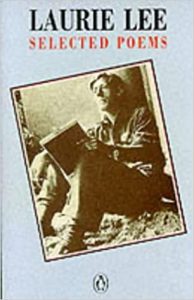I often think about Laurie Lee’s Cock Pheasant “gilded with leaf-thick paint” swaggering across “the cidrous banks of autumn”. We used to see a lot of pheasants when I lived in Kent and I’ve never read a more apt description.
Yet, all the online information, including obituaries, asserts that Lee (1914-1997) struggled to achieve recognition as a poet. Yes of course I read his prose works especially Cider with Rosie which was heavily promoted at my teacher training college because it was, they said, a fine presentation of a child growing up. It was certainly evocative as were its sequels As I Walked Out One Midsummer Morning and A Moment of War. For a long time Cider With Rosie was standard fare on secondary school syllabuses too but I think it’s a bit too English, white and dated to tick the boxes in 2023.
We shouldn’t underestimate him as a poet, in my view. I first stared to explore his poems when an anthology called Poets of Our Time was set for the O Level classes I was teaching – yes, it was a while ago now. Poets of Our Time was edited by Chris Woodhead, fondly (or not) remembered by teachers as HM Inspector of Schools from 1994-2000. He was an English teacher long before he achieved fame – or notoriety, depending on your point of view.
I’ve recently started to dip into Lee’s poems again. “Sunken Evening”, for instance, is a stunning depiction of dusk in central London in the 1950s. It’s based on a sustained metaphor comparing the withdrawal of workers from town at the end of the day with the tide going out. Thus “crusted lobster-buses crawl/ Among the fountain’s silver weed” and “There, like a wreck, with mast and bell, /The torn church settles by the bow, / while phosphorescent starlings stow / Their mussel shells along the hull”.
What a wordsmith!
Lee’s poem “Christmas Landscape” is quite something too. Biting cold becomes “the wind gnaws with teeth of glass” – and yet there is warmth and life as “in a nest of ruins the blessed babe is laid” although there’s a “cry of anguish” as “the cold earth is suckled”.
Or what about “My Many-Coated Man” in which Lee gives us four contrasting animal pictures from the “padded spicy tiger” to the “rank red fox” and the “mottled moth”. I like the vulnerability of the “the turtle on the naked sand” who “peels to air his pewter snout” best. Then in the final stanza he compares these with the complexity of man “hooded by a smile”.
Lee is a good poet. And like all good poets he is master of form as well as message. He’s well worth reading and I’d like to see a revival of interest in his work. Have I started the ball rolling?

Next week on Susan’s Bookshelves: Jane Eyre by Charlotte Bronte